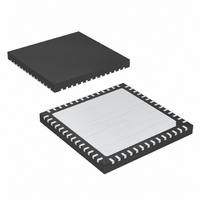MAX19713ETN+ Maxim Integrated Products, MAX19713ETN+ Datasheet - Page 33

MAX19713ETN+
Manufacturer Part Number
MAX19713ETN+
Description
IC ANLG FRONT END 45MSPS 56-TQFN
Manufacturer
Maxim Integrated Products
Datasheet
1.MAX19713ETN.pdf
(37 pages)
Specifications of MAX19713ETN+
Number Of Bits
10
Number Of Channels
2
Power (watts)
91.8mW
Voltage - Supply, Analog
3V
Voltage - Supply, Digital
3V
Package / Case
56-TQFN Exposed Pad
Lead Free Status / RoHS Status
Lead free / RoHS Compliant
Differential nonlinearity is the difference between an
actual step width and the ideal value of 1 LSB. A DNL
error specification of less than 1 LSB guarantees no
missing codes (ADC) and a monotonic transfer function
(ADC and DAC) (DAC Figure 14b).
Ideally, the midscale transition occurs at 0.5 LSB above
midscale. The offset error is the amount of deviation
between the measured transition point and the ideal
transition point.
Offset error (Figure 14a) is the difference between the
ideal and actual offset point. The offset point is the out-
put value when the digital input is midscale. This error
affects all codes by the same amount and usually can
be compensated by trimming.
Ideally, the ADC full-scale transition occurs at 1.5 LSB
below full scale. The gain error is the amount of devia-
tion between the measured transition point and the
ideal transition point with the offset error removed.
Figure 15 shows the aperture jitter (t
sample-to-sample variation in the aperture delay.
Aperture delay (t
rising edge of the sampling clock and the instant when
an actual sample is taken (Figure 15).
For a waveform perfectly reconstructed from digital
samples, the theoretical maximum SNR is the ratio of
the full-scale analog input (RMS value) to the RMS
quantization error (residual error) and results directly
from the ADC’s resolution (N bits):
In reality, there are other noise sources besides quanti-
zation noise: thermal noise, reference noise, clock jitter,
etc. SNR is computed by taking the ratio of the RMS
signal to the RMS noise. RMS noise includes all spec-
tral components to the Nyquist frequency excluding the
fundamental, the first five harmonics, and the DC offset.
SINAD is computed by taking the ratio of the RMS sig-
nal to the RMS noise. RMS noise includes all spectral
components to the Nyquist frequency excluding the
fundamental and the DC offset.
ADC Dynamic Parameter Definitions
SNR(max) = 6.02 x N + 1.76 (in dB)
Signal-to-Noise and Distortion (SINAD)
AD
______________________________________________________________________________________
) is the time defined between the
Differential Nonlinearity (DNL)
Signal-to-Noise Ratio (SNR)
ADC Offset Error
DAC Offset Error
AJ
ADC Gain Error
Aperture Delay
Aperture Jitter
), which is the
10-Bit, 45Msps, Full-Duplex
Figure 14a. Integral Nonlinearity
Figure 14b. Differential Nonlinearity
Figure 15. T/H Aperture Timing
DATA (T/H)
SAMPLED
ANALOG
INPUT
6
5
4
3
2
1
0
7
6
5
4
3
2
1
0
CLK
T/H
Analog Front-End
000
000
t
AD
TRACK
001
001
010
DIGITAL INPUT CODE
DIGITAL INPUT CODE
010
AT STEP
001 (0.25 LSB)
011
1 LSB
011
t
HOLD
AJ
DIFFERENTIAL
LINEARITY ERROR (+0.25 LSB)
100
AT STEP
011 (0.5 LSB)
DIFFERENTIAL LINEARITY
ERROR (-0.25 LSB)
100
101
101
110
TRACK
1 LSB
111
33








